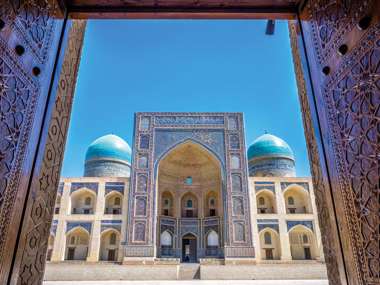A personal account from Uzbekistan
Landing in Tashkent, I was unsure what to expect from Uzbekistan, but I can say without a doubt it pleasantly exceeded any expectation I had within the first day.
I first noticed how green the city is with a multitude of parks and roads lined with lush trees and flowers. My next thought was how clean the city is! What a lovely first impression of Uzbekistan’s capital city.
Arriving at our hotel in Tashkent, we had a very organized and quick check in after landing in the early hours of the morning. This gave us a few hours to catch up on some sleep before enjoying breakfast and starting our tour of Tashkent. Having met our guide for the entire tour at the airport earlier, we were also greeted by our local city guide who filled our heads throughout the day with the history and culture of Tashkent.
We started our day by visiting the Khasti-Imam Complex which also holds the library of the oldest Quran in the world and impressive 50-metre-high minarets. This was also our first introduction to the beautifully detailed and intricate mosaic work of Uzbek mosques.
From here, we made our way to Mustaqillik (Independence) Square. This allowed me the opportunity to take in the modern architecture of Tashkent. The main square is clean and open, showcasing a large fountain and towering sculpture featuring the iconic Uzbekistan stork, which is a symbol of peaceful politics throughout the country. Independence Square is backed by a beautifully kept park featuring the Happy Mother Monument who watches over the city and its people. Having visited only two sites at this point in the day, you soon realize how incredible Tashkent has blended the old and new history and culture in one.
We were then able to escape the afternoon sun by heading underground to Central Asia’s oldest subway system. We were able to ride the metro to three different stations, each uniquely decorated with everything from glass tiles that, to me, resembled a mermaid under water to sparkling chandeliers. After learning that photos were prohibited until 2018 because of its second role as a nuclear bomb shelter with the military, I was quick to capture the stunning art that each station proved to be.
Emerging from the metro station, we then had a relaxing lunch in a café near the Museum of Applied Arts (which would be our next stop). Housing over 7000 priceless pieces of ceramics, carpets, jewellery, and embroidery called suzani (which translates to needle), we admired the meaning behind all the patterns stitched in the suzani from everyday bedding to single use marital blankets.

After a pleasant surprise from our guide that our train to Bukhara the next day would depart at 9AM (rather than 7AM), we happy to retire to the hotel for a lovely 3 course meal.
The next day, our very punctual train departed Tashkent for Bukhara. The next 4 hours went by quickly as train attendants walked past with a variety of food and drinks. We all found the train to be very clean and comfortable with western style toilets and European (2 prong) outlets to charge gadgets. Leaving the green city of Tashkent, the Uzbekistan countryside hosted a variety of landscape from desert and farmland to ancient mountains.
Walking through the narrow streets of the Jewish Quarter and the energy of the markets in Bukhara, I felt like I had been transported back in time. The old city is situated around Lyabi-Khauz (By the Pool’) Square and our hotel was perfectly located across the street. Constructed in the 16th and 17th century, the pool was once used to gather fresh water, bathing, and drinking. The pool is surrounded on three sides by different buildings of religious significance. The oldest is the Kukeldash Madrassah, constructed between 1568-69. Standing on the west side of the pool and served as accommodation for visiting holy men, is the Nadir Divan-Beghi Khanqah, built between 1619-20. Originally built as a caravanserai, the eastern side of the pool stands Nadir Divanbegi Madrassah which was built in 1622-23. Each building is richly decorated with bright tile work of blue, green, and gold.
As a prominent stop on the Silk Road, the city of Bukhara, which is more than 2000 years old, lived up to the reputation as home to Uzbekistan’s most intricate and important ancient buildings. While the old city of Bukhara is known for its Mosques, Mausoleums, Minarets and Madrasahs, it is also famous for its undercover bazaars. As we casually wandered the streets, the shop owners were very happy to take the time to teach us about their craft without being pushy to buy and there was no limit on the number of silks, rugs, hand crafted jewellery or scissors shaped like storks to buy as gift or souvenir.
Samarkand, to me, proved to be the gem of the tour. The city is lined with dazzling rooftops of blue and gold from the Gur Emir mausoleum and Bibi-Khanym Mosque to the outstanding Registan Square. With all there is to see in the city, our guide suggested that we visit Gur Emir mausoleum when we first arrived late in the afternoon. This would give us a more time and a relaxed pace the next day. The mausoleum contains the tombs of the conqueror Tamerlane (also known as Timur) as well as his descendants. The sheer architecture of the building and dome is something to be appreciated and admired. Outwardly the building is covered in blue and white geometric tiles and terracotta bricks while the inside walls are composed of onyx walls and refined paintings.
The next day we visited the Bibi-Khanym Mosque. Which was of special significance to our guide as her grandmother was buried there. As soon as we turned the corner and up the steps, my jaw dropped at the brilliant azure buildings shining in the sunlight on each side of a path through a village of mosques, each elaborately decorated. I could have spent hours admiring the craftsmanship and detail of the mosaics.

The previous evening after dinner, our guide brought us to Registan Square for a 10 minute sneak preview, while it was colourfully lit up with various spot lights (mine was the vibrate blue) and bustling with people who emerge in the cooler evenings to admire the square and enjoy an evening ice cream. Needless to say, we were all anticipating going back the next day! After lunch we walked through the near by park and entered the side gate to the square. Looking like a totally different, but equally as beautiful, building in the day light, we were lucky to find a small amount of people in the square and an opportune time to snap photos. Registan Square was once used for meeting, lectures and dormitories to executions. Today, it is the heart of the city being the centre of arts and public life.
Experiencing the warm hospitality from the Uzbekistan people, it left me sad to leave. It offered so much more than I had expected in the short amount of time I had visited. Having only seen a small portion of such a vast country, I hope to one day return to experience more that Uzbekistan has to offer, such as the Ferghana Valley.





